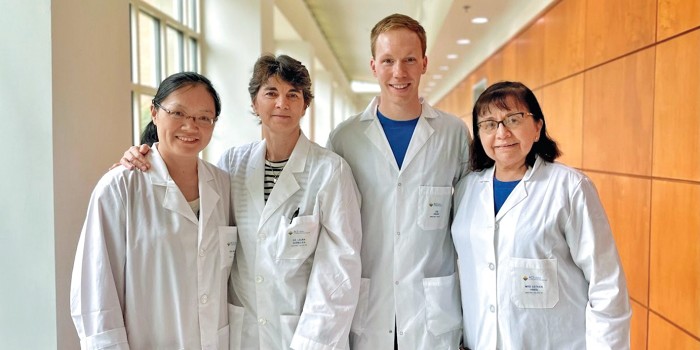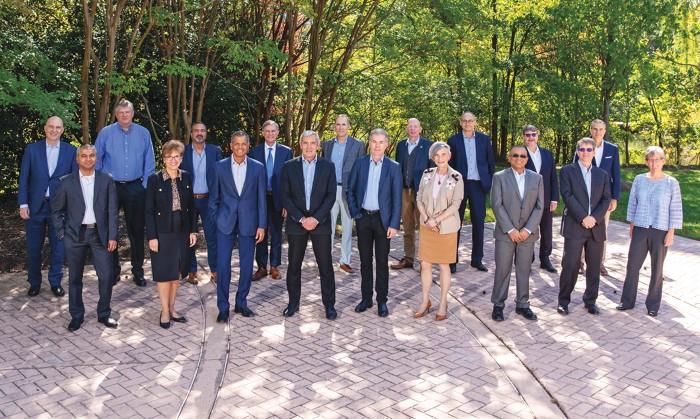Advertisement
Grab your lab coat. Let's get started
Welcome!
Welcome!
Create an account below to get 6 C&EN articles per month, receive newsletters and more - all free.
It seems this is your first time logging in online. Please enter the following information to continue.
As an ACS member you automatically get access to this site. All we need is few more details to create your reading experience.
Not you? Sign in with a different account.
Not you? Sign in with a different account.
ERROR 1
ERROR 1
ERROR 2
ERROR 2
ERROR 2
ERROR 2
ERROR 2
Password and Confirm password must match.
If you have an ACS member number, please enter it here so we can link this account to your membership. (optional)
ERROR 2
ACS values your privacy. By submitting your information, you are gaining access to C&EN and subscribing to our weekly newsletter. We use the information you provide to make your reading experience better, and we will never sell your data to third party members.
Programs
ACS Bridge Program makes an impact
Mentorship is key to the program’s success in diversifying the chemical sciences
by Linda Wang
March 9, 2021
| A version of this story appeared in
Volume 99, Issue 9
Joe Rodriguez had a tough time adjusting to college, and his grades suffered as a result. “I just wasn’t mature, and I failed miserably,” he says. Rodriguez enlisted in the US Marine Corps, and he says that experience gave him the discipline he needed to turn his life around. He eventually earned a bachelor’s degree in chemistry from the University of North Carolina Wilmington.

After graduating, Rodriguez worked for a small pharmaceutical company and realized that he wanted to pursue a PhD in chemistry. But he worried that because his grades hadn’t been stellar, he would have a difficult time getting into any competitive programs.
Rodriguez learned about the American Chemical Society Bridge Program, applied, and was accepted. He is now a PhD student at the Ohio State University. “The Bridge Program gave me an opportunity to get into a PhD program for chemistry that I absolutely would not have had otherwise,” he says.
Launched in 2018, the ACS Bridge Program is part of the ACS Bridge Project and aims to increase the number of Black, Latino, and Indigenous students earning doctoral degrees in the chemical sciences. The program is part of the NSF INCLUDES Alliance: Inclusive Graduate Education Network (IGEN) and is supported by a grant from the US National Science Foundation, with additional funding from the Genentech Foundation. The ACS Bridge Program is modeled after the successful American Physical Society Bridge Program, which matches students accepted into the program with partner institutions that provide individualized mentoring and support.
“Initiatives like the ACS Bridge Project are tangible ways we can work to dismantle systemic barriers and create more equitable pathways into sustainable careers in science and medicine for underrepresented groups,” says Kristin Campbell Reed, executive director of the Genentech Foundation and corporate and employee giving at Genentech.
Prospective students fill out a single application and are considered by all the institutions participating in the program. Currently, 23 departments at 22 institutions are participating in the ACS Bridge Program. Each department will accept up to five Bridge fellows per year.
Douglas Raynie, who leads the program at South Dakota State University, says that a universal application process exposes students to schools both large and small they may not have considered if they hadn’t applied for the Bridge Program.
The ACS Bridge Program is not one size fits all, and that’s what makes it work, according to students and Bridge leaders. “You definitely cannot have a cookie-cutter mentality, because these students have such different backgrounds and such different needs,” says Robert J. Hamers, who leads the program at the University of Wisconsin–Madison.
Some institutions offer a 1-year postbaccalaureate program, whereas others offer a 2-year master’s program. They all share a strong mentorship component and a goal to help students transition from the Bridge Program into a PhD program.
Current ACS Bridge Program institutions
Brown University
California State University, Fresno
City University of New York
Columbia University
Florida Agricultural and Mechanical University
Georgia Institute of Technology
Indiana University Bloomington
Northeastern University
Ohio State University
South Dakota State University
Stony Brook University
University of Alabama
University of Arkansas, Fayetteville
University of California San Diego
University of Illinois at Chicago
University of Massachusetts Amherst
University of Michigan
University of Northern Colorado
University of Rochester
University of Washington
University of Wisconsin–Madison
Villanova University
The individualized support starts as soon as students are matched and choose the school they will join. “We’re going to have a one-on-one discussion with you before you even arrive on campus and develop a unique plan of how you’re going to take your classes and structure it so that it fits you,” says Carson Meredith, who leads the program at the Georgia Institute of Technology.
Michael Knapp, who leads the program at the University of Massachusetts Amherst, says the school tries to make the experience as typical of a PhD as possible. “I think we’ve all worked with people where they really don’t need or don’t want a lot of hand-holding. But making sure that the trampoline is there when you’re on the high wire is really important so that if you fall off, you can bounce back,” he says.

Jairo Villalona, who is in a PhD program at the University of Wisconsin–Madison, says the Bridge experience has given him both the skills and confidence to succeed in a PhD program. “Through the process, I’ve learned how to become a critical thinker,” he says. “One of the things that I really like about the Bridge Program is that there is a very good community network in place to not only support you as a scientist but also as a person.” In addition to individualized mentorship and support, students attend conferences such as the IGEN National Meeting.
Some programs have waived the requirement for Bridge students to serve as teaching assistants in their first year. “It was really essential for me not to teach because then I can concentrate purely on my classes and finding out what I wanted to do in research,” says Isel Rivera, who is in the Bridge Program at Indiana University Bloomington. She says having the Bridge support network was especially critical during the height of the pandemic, when contact with her peers was limited.

“The Bridge Program is a small cohort of students where you can really try out different types of mentoring structures and support networks,” says Sara Skrabalak, who serves as a mentor for the program at Indiana University Bloomington. “We’re hoping that we can scale this into our larger [graduate] program, providing more flexibility and personalized attention at a larger scale.”
Bridge leaders say that when selecting Bridge fellows, they look for passion, determination, and grit. “We look for people who have indications of some foundational strength in chemistry, who have perseverance, and who have demonstrated independent learning. That really helps us decide that this person is going to be able to succeed in this program, and that’s going to put them in a position to be able to excel the next year,” says Thomas J. Magliery, who leads the program at the Ohio State University.
“It’s trying to identify who are those students where this little bump that we can provide will most likely make a big difference,” Hamers says.
For Bridge fellows, that bump in confidence is life changing. “They saw something in me and ran with it, and because of it, I am now accomplishing my PhD,” Rodriguez says. “I think that says that I had the capacity to accomplish a PhD. I just never had the proper motivation or opportunity.”
Student applications for the 2021–22 Bridge Program are being accepted through March 31. Apply at www.acs.org/bridgeprogram.
Correction
This story was updated on March 10, 2021, to correct a photo credit. The photo of Jairo Villalona was taken by Kolin Goldschmidt/University of Wisconsin–Madison.





Join the conversation
Contact the reporter
Submit a Letter to the Editor for publication
Engage with us on Twitter